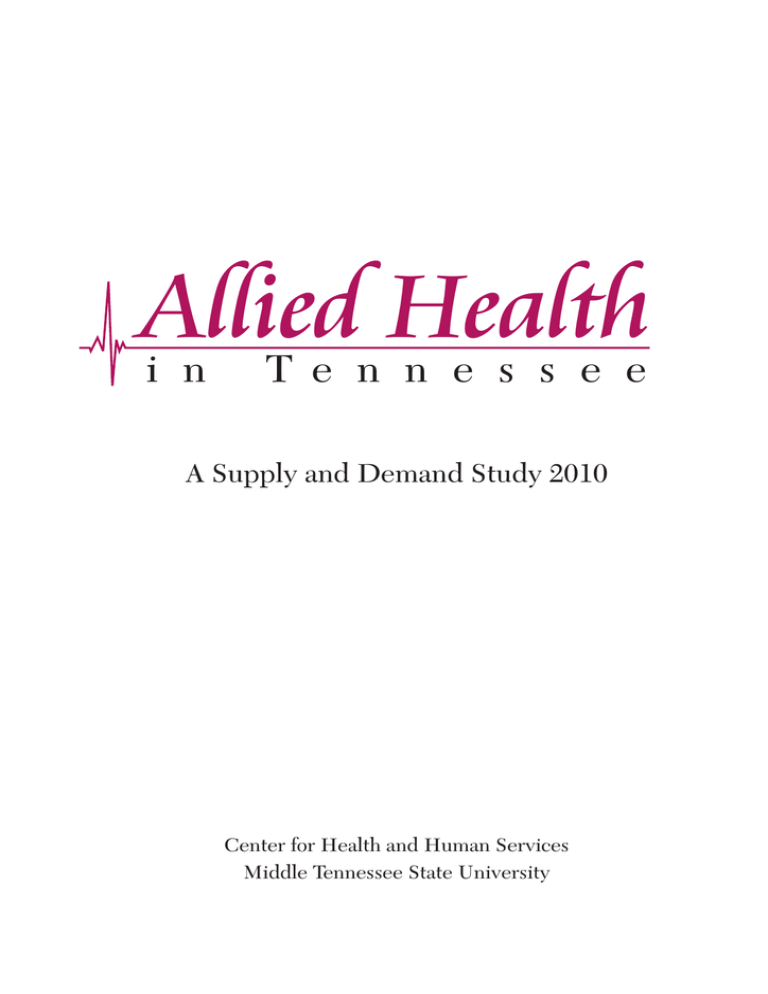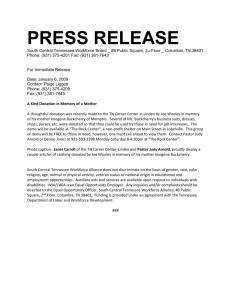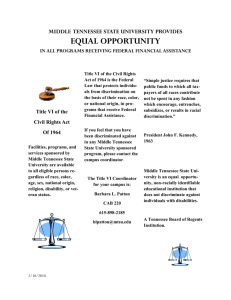Allied Health A Supply and Demand Study 2010
advertisement

Allied Health i n T e n n e s s e e A Supply and Demand Study 2010 Center for Health and Human Services Middle Tennessee State University Allied Health i n T e n n e s s e e Foreword Allied health workers constitute the largest component of the U.S. health care workforce, but this group is often one of the least studied. Consequently, having accurate and comprehensive information and data about this collection of disciplines is vital to effective operations and planning on the part of employers and education and government leaders. Over the years Tennessee has been well served by Dr. Jo Edwards and her collaborators who have monitored and reported on the status of allied health workforce supply and demand in the state. This fourth edition of Allied Health in Tennessee provides an indispensable reference of interest and use to a wide audience. This publication is especially timely in view of the ongoing evolution of health care in the U.S. and concerns about the need for various types of health reform—all of which impact supply and demand for allied health professionals. While data on health workforce needs and supply at the national level are useful, it is important to remember that health care is delivered at local and regional levels. Thus, having relevant information at the local and state level is essential for good planning. In general, the lower the educational level of the allied health worker, the more place-bound or less mobile is that individual. As a result, the location of academic programs has a great influence on the availability or lack thereof of an adequate health care workforce. iii Even with a national economic slowdown over the last few years, health care remains one of the strongest components of the U.S. economy, with continued growth expected. It is also anticipated that many who have either returned to the health care workforce over the last few years (or those who might have retired but did not) will most likely retire when the economy improves, creating again the prospect of significant worker shortages. This book, by offering a compilation of academic programs and their location in Tennessee as well as pertinent information about each field, should be of great value to potential students, educational planners, and state officials. Stephen N. Collier, Ph.D. Director and Professor Office of Health Professions Education and Workforce Development School of Health Professions The University of Alabama at Birmingham iv Table of Contents Acknowledgements ................................................................... vii Executive Summary ................................................................. viii Introduction Background ................................................................................. 2 Objectives of the Study............................................................... 3 What Is Allied Health? ............................................................... 3 Rationale for the Study ............................................................... 5 Scope of the Study ...................................................................... 7 Educational Guide ...................................................................... 8 Methodology ............................................................................... 9 Institutions of Learning Included in Study ............................. 12 Therapeutic Services Rehabilitation Professions ........................................................ 16 Physical Therapist and Physical Therapist Assistant ........................16 Occupational Therapist and Occupational Therapist Assistant .......23 Athletic Trainer ...................................................................................30 Recreational Therapist .......................................................................34 Speech-Language Pathologist and Assistant and Audiologist ................................................................................38 Respiratory Therapist and Respiratory Therapist Technician .........46 Dietitian/Nutritionist and Dietetic Technician .................................51 Surgical Technologist .........................................................................57 Physician Assistant .................................................................... 60 Emergency Medical Services ................................................... 63 Emergency Medical Technician (EMT) ............................................63 Dental Services ......................................................................... 69 Dental Hygienist and Dental Assistant .............................................69 v Diagnostic Services Medical Imaging ....................................................................... 76 Diagnostic Radiologic Technologist ..................................................77 Radiation Therapist ............................................................................84 Nuclear Medicine Technologist .........................................................87 Diagnostic Medical Sonographer ......................................................92 Laboratory Services ................................................................. 96 Medical Technologist, Medical Laboratory Technician, Phlebotomist ...............................................................96 Health Informatics (Medical Records) Health Information Services .................................................. 106 Health Information Administrator...................................................106 Health Information Technician........................................................106 Medical Transcriptionist ..................................................................106 Epidemiologist ....................................................................... 113 Support Services Medical Assisting .................................................................... 118 Medical Assistant..............................................................................118 Nursing Assistant..............................................................................122 References and Appendices References and Bibliography ................................................. 128 Appendix A: Tennessee Programs .......................................... 130 Appendix B: Websites of Interest ........................................... 160 Appendix C: Accreditation Information................................. 165 Appendix D: Local Data Tennessee Metropolitan Statistical Areas Top 100 U.S. Labor Markets and Estimated Non-farm Employment Changes 2008–2009.......................................................... 167 2007–2008 Joint Annual Report (JAR)............................. 174 Appendix E: Joint Annual Review Statewide Vacancy Rates .................................................. 180 Appendix F: Population Ratio Data ........................................ 182 Appendix G: BLS Projected Employment Change 2008–2018 ........................................................... 183 Appendix H: Contributors ...................................................... 187 vi Acknowledgements A project of this complexity relies on the efforts of many, including task force members and their institutions; allied health administrators and faculty; and state, regional, and national agencies and associations. A large number of professionals in the various occupational areas provided information, read drafts of the report sections, and provided valuable advice and suggestions. We gratefully acknowledge the contributions of all these individuals and organizations. Funding for the printing of the fourth edition was provided by the Center for Health Workforce Development in Tennessee of the Tennessee Hospital Association (THA) and by the Nashville Career Advancement Center (NCAC). This study is a major project of the Adams Chair of Excellence in Health Care Services at Middle Tennessee State University. Jo Edwards, Ed.D. Adams Chair of Excellence in Health Care Services Center for Health and Human Services Middle Tennessee State University Kaylene Gebert, Ph.D. Professor Department of Speech and Theatre Middle Tennessee State University Cynthia Chafin, M.Ed., CHES Project Director Center for Health and Human Services Middle Tennessee State University Stephen N. Collier, Ph.D. Director and Professor Office of Health Professions Education and Workforce Development School of Health Professions University of Alabama at Birmingham vii


